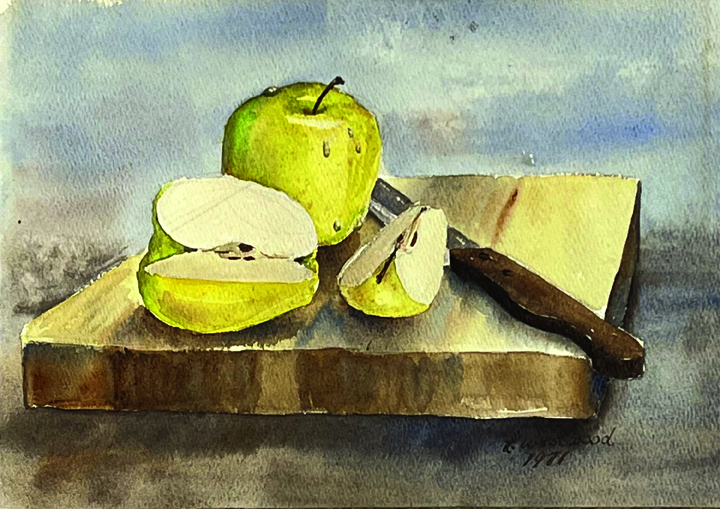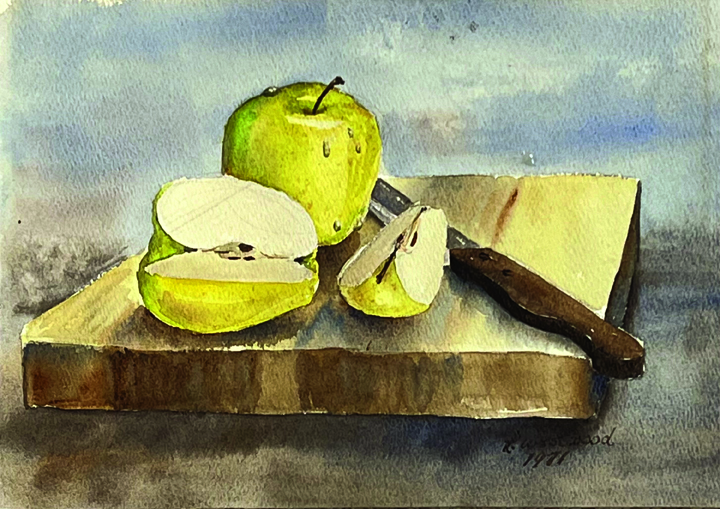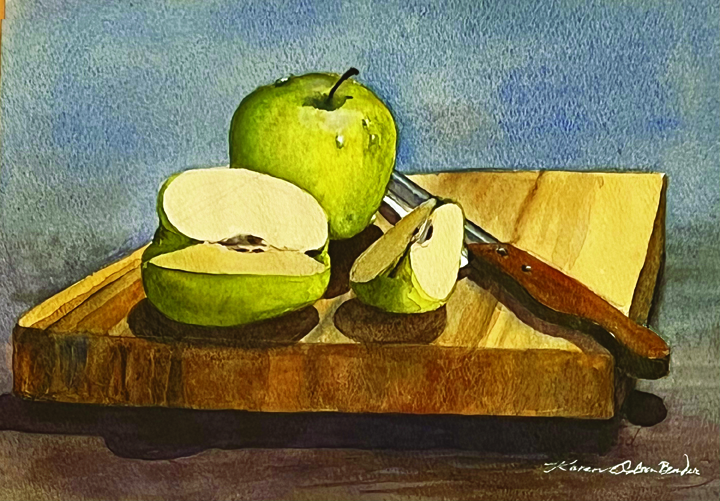The archaeological project referenced above started about two years ago. The dig site is my house, and the artifacts I am discovering are buried in layers of accumulation in my cupboards and closets. There are always surprises in archaeology, and a recent one in this dig turned up at the bottom of a cardboard box that sat on a closet floor, under a stack of cardboard boxes that almost reached the ceiling. When I burrowed into this box, I found some paintings that I did decades ago when I was first learning watercolor. I was surprised to find them, because just about all of those early efforts landed in the waste basket. A few somehow escaped. This was one of them.

At one time, like many would-be watercolorists, I was thoroughly intimidated because I had since childhood bought into the trope that this medium is extraordinarily difficult. But upon seeing these ancient paintings again I was transported back to the time when I first ventured into the secret world of watercolor and discovered that maybe it might be possible to access it! (The secret was, of course, having the good fortune to find an excellent teacher, a young woman who owned a little art supply shop in the town I lived in at the time, and who gave lessons in the storeroom in back of the shop). That these little paintings reflected the work of an early learner was absolutely clear. But that they also contained some promise was also clear, though I surely didn’t recognize that at the time. I took one out of the box. What would happen if, after all these years, I finished it? FINISHED it? Wasn’t it already finished? I had thought so when I painted it. But seeing it again, after so long a time, I couldn’t resist messing with it.

And now that I look at the changes I made, I can see that, without realizing it, I had come under the strong influence of my stay in Amsterdam over Christmas/New Year’s. I had spent a good part of that time looking at Golden Age Dutch painting—and without my realizing what was happening, that intense visual experience was making its way into this painting! And if you are familiar with this style of art, you can see exactly what I’m talking about!
So what, exactly, did I do with this old thing? Let’s look at the early version again (below).

I must have liked the painting when I did it, which would not been very typical of my feelings at the time, but for some reason I didn’t want to consign it to the trash. I actually still sort of like it, but I can see how crude it is. The washes are tentative and look like they were done by a nervous artist. The knife wasn’t drawn well and is missing a shadow that should be seen extending beyond the edge of the cutting board on the table surface. The cutting board itself is really wobbly. And the edges on the apples, where they juxtapose with the cutting board, are not done carefully. Again no doubt the artist was very nervous!

So let me tell you about the revisions. First I put all new washes on the whole piece. I would have been scared to death to put a wash on top of a wash when I first did the painting. But in time that I learned that painting in layers is a time-honored technique with a name—glazing—and that the fear I had had that the underpainting would all dissolve and disappear was groundless. Anyway, on the background and table surfaces I applied blue and burnt sienna washes. And on the apples and cutting board I put on a warm yellow wash (cadmium yellow, very thin). These washes resulted in the darkening and warming-up of the entire piece. And I wanted more dramatic high-contrast lighting in place of the tentative shadows in the earlier piece, so I darkened and sharpened the cast shadows. I am sure I picked up these impulses subconsciously from having spent those happy hours with Rembrandt, Vermeer, Hals, and other magnificent Dutch painters while I was in Amsterdam. Their domestic interiors often were very warm, rich with color and dramatic lighting. Just a note—soft shadows like what I did in the early piece are certainly a viable choice. The problem in that piece is that it’s clear I was without the vaguest notion of how the paint was going to behave! That is, I very tentatively dabbed the paper with the brush, essentially trusting to blind luck that something like a shadow would happen!
Coda: You can see more blogs on my website, karenolsenfineart.com/blog/. Most of my paintings are available for purchase. Some originals. All as archival prints. These are also on my site: karenolsenfineart.com/galleries/ This one is not uploaded yet, but here are the details. Size (unframed): 8.25″ x 11″. Medium: watercolor on Arches paper.